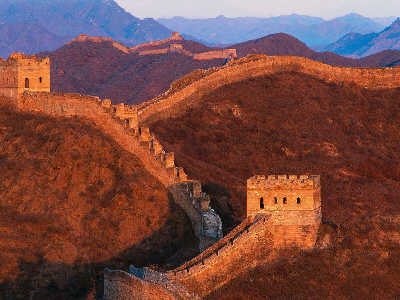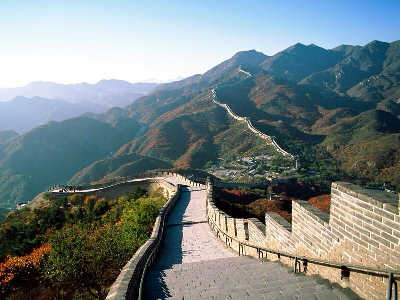

The human race is rich in creative power but has never been content with its lot, with material limitation, but instead has tried hard to transcend it spiritually. A batch of ancient artistic creations such as oral literature, dances, music, drawing and sculptures, were admirable evidence of this in the distant past. Architectural art, considered to be the earliest art of mankind, naturally also found expression. China'sGreat Wallis a famous example that transcends ideology. Far back to the WesternZhou Dynastyin the 9th century BC, people began to build beacon towers along the borderline. When the enemy came, people used fires on the towers to provide early warning.
During the Spring and AutumnWarring States Period, mutually defensive beacon towers were also built along the national boundaries between various countries. In the middle of the 7th century BC, in order to link up various isolated beacon towers bordering the state of Qin, Chu State was the first to set up city walls, becoming the earliest part of theGreat Wall. Later, similar walls were built one after another by various states. After Qinshihuang unified China, he demolished the walls between the various states, leaving behind only those of Yan, Zhao and Qin and linked them together, so as to resist the attack by northern nomadic people. This section of the Great Wall goes west from Lintao and east to Liaodong.
The Han Dynastyextended the Great Wall toward the west and setup the Yumenguan Pass and the Yangguan Pass in Gansu'sDunhuang. Various post-Han dynasties all maintained the Great Wall, with theMing Dynastyseeing the largest scale of maintenance work, by completing the greatest human project stretching more than 11,300 li (0.5 km =one li) across north China east to Liaodong and west to Gansu's Jiayuguan Pass. The Great Wall has inner and outer layers, and has more than 2Olayers in some sections. When all the city walls are put together, the Great Wall built during the 2,000 years throughout all dynasties totals 100,000 li, long enough to circle the globe. Historically, the Great Wall had played a great role, guarding against the inroads of the northern nomadic people and guaranteeing the tranquillity of the central plain, ensuring the unimpeded traffic of theSilk Roadfor economic and cultural exchanges between Chinese and Western countries, and promoting peace, trade and exchanges among various nationalities at frontier points.
Today, the practical functions of the Great Wall as defense work no longer exist, but its beauty has long remained up to this date, becoming the object of beauty for sightseeing.
The city walls of the Great Wall extends mostly along the undulating mountain ridges, with close interdependence of precipitous topography-mountains and walls in the Outer side of the mountain ridges often made use of to reinforce the structure. The mystical picture resulting from the combination of points, lines and areas formed by the majestic passes, rotating city walls, strong towers, turrets, enemy fortresses and solitary and unique beacon towers have all become part of the rhythm of beauty. Nature, which originally is completely unrestrained and lacking in feeling, once it become part of people's judgment, becomes a thing closely related with their feelings.

Copyright ©1999-2011 Chinanews.com. All rights reserved.
Reproduction in whole or in part without permission is prohibited.